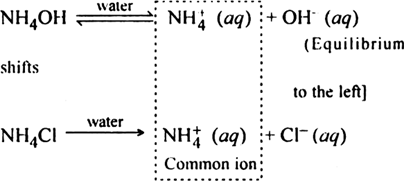 Short Answer Type
Short Answer Type
 ions, the degree of dissociation of NH4OH is suppressed, so the concentration of hydroxide ions decreases and thereby the ionic product of the hydroxides of group III cations decreases. Even with their suppressed concentration of OH– ions, their ionic products exceed the solubility product and hence radicals of group III get precipitated. The solubility products of hydroxides of higher group cations are relatively high and thus these cations are not precipitated in group III.
ions, the degree of dissociation of NH4OH is suppressed, so the concentration of hydroxide ions decreases and thereby the ionic product of the hydroxides of group III cations decreases. Even with their suppressed concentration of OH– ions, their ionic products exceed the solubility product and hence radicals of group III get precipitated. The solubility products of hydroxides of higher group cations are relatively high and thus these cations are not precipitated in group III. Long Answer Type
Long Answer Type Short Answer Type
Short Answer TypeGive reason: The precipitation of Mg(OH)2 is prevented by the addition of NH4Cl prior to the addition of NH4OH. But its precipitation by NaOH is not prevented by the prior addition of NaCl.
In which of the following, silver chloride will dissolve more:
(i) Pure water
(ii) 0·1M AgNO3 solution?
 Multiple Choice Questions
Multiple Choice QuestionsThe equilibrium constant at 298 K for a reaction A+B ⇌ C+D is 100. If the initial concentration of all the four species were 1 M each, then equilibrium concentration of D (in mol L−1 ) will be:
0.818
1.818
1.182
1.182
For the reaction,
if Kp = Kc (RT)x where the symbol has usual meaning then the value of x is (assuming ideality)
-1
-1/2
1/2
1/2
The species which can best serve as an initiator for the cationic polymerization is
LiAlH4
HNO3
AlCl3
AlCl3
The equilibrium constant (Kc) for the reaction, N2(g) + O2 (g) → 2NO (g) at temperature T is 4 x 10-4. The value of Kc for the reaction  at the same temperature is
at the same temperature is
0.02
2.5 x 102
4 x 10-4
4 x 10-4
